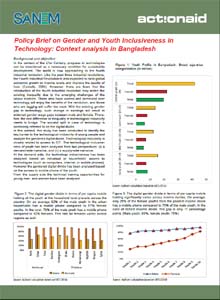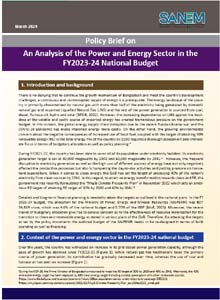
SANEM-AAB Policy Brief on Gender and Youth Inclusiveness in Technology Context analysis in Bangladesh
 In the context of the 21st Century, progress in technologies can be considered as a necessary condition for sustainable development. The world is now approaching to the fourth industrial revolution. Like the past three industrial revolutions, the Fourth Industrial Revolution is also expected to raise global economic growth or income levels and improve the quality of lives (Castells, 2004). However, there are fears that the introduction of the fourth industrial revolution may widen the existing inequality due to the emerging challenges of the labour markets. Those who have access and command over technology will enjoy the benefits of the revolution, and those who are lagging will suffer the most. With the existing gender gap in technology, such change in earnings will result in widened gender wage gaps between male and female. Therefore, the real difference or inequality in technological inclusivity needs to bridge. The societal split in case of technology is commonly referred to as the digital divide. In this context, this study has been conducted to identify the key barrier to the technological inclusivity of young people and analyze the gendered digital divide. Technological inclusivity is closely related to access to ICT. The technological inclusiveness of youth has been analysed from two perspectives: (i) a demand-side narrative, and (ii) a supply-side narrative. At the demand side, the technology inclusiveness has been analysed based on individual or households’ access to technologies (such as computers, internet, or mobile phones). However the gendered digital divide has been analysed based on the access to mobile phone of the youth. From the supply side the technical training opportunities for young men and women have been analysed.
In the context of the 21st Century, progress in technologies can be considered as a necessary condition for sustainable development. The world is now approaching to the fourth industrial revolution. Like the past three industrial revolutions, the Fourth Industrial Revolution is also expected to raise global economic growth or income levels and improve the quality of lives (Castells, 2004). However, there are fears that the introduction of the fourth industrial revolution may widen the existing inequality due to the emerging challenges of the labour markets. Those who have access and command over technology will enjoy the benefits of the revolution, and those who are lagging will suffer the most. With the existing gender gap in technology, such change in earnings will result in widened gender wage gaps between male and female. Therefore, the real difference or inequality in technological inclusivity needs to bridge. The societal split in case of technology is commonly referred to as the digital divide. In this context, this study has been conducted to identify the key barrier to the technological inclusivity of young people and analyze the gendered digital divide. Technological inclusivity is closely related to access to ICT. The technological inclusiveness of youth has been analysed from two perspectives: (i) a demand-side narrative, and (ii) a supply-side narrative. At the demand side, the technology inclusiveness has been analysed based on individual or households’ access to technologies (such as computers, internet, or mobile phones). However the gendered digital divide has been analysed based on the access to mobile phone of the youth. From the supply side the technical training opportunities for young men and women have been analysed.



